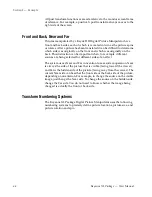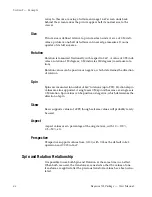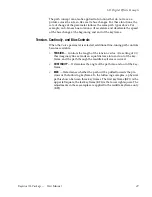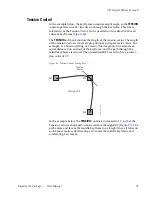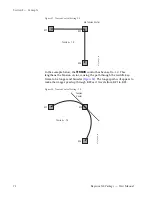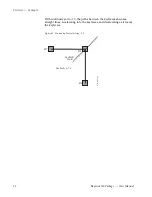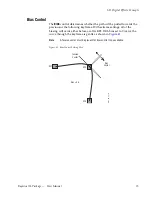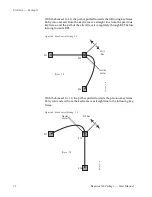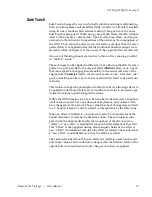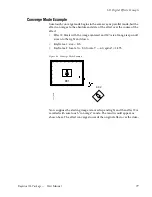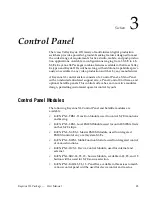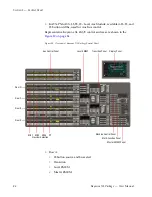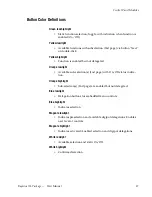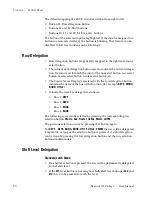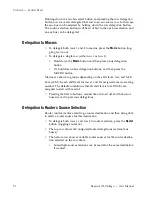
Kayenne XL Package — User Manual
77
3-D Digital Effects Concepts
Sure Touch
Sure Touch changes the way in which effects behave during recall and play-
back, providing more control and flexibility. An effect can be safely recalled
using two new modes which eliminate abrupt changes: hence the name
Sure Touch is being used. When using a Sure Touch mode, the effect adapts
itself to the switcher’s current state. Upon recall of any effect, no changes
are made to the current state, regardless of the nature or the composition of
the effect. Then, when the effect is run, the relative changes from the inter-
polated effect are applied instead of the traditional absolute output. Only
elements which changed over the course of the original effect are affected.
One way of thinking about safe touch is to think of it as running an effect
in “relative” mode.
These changes can be applied in different ways, allowing the effect to inter-
polate on a path parallel to the original effect (
Parallel
mode), or on a path
that converges the changing state smoothly to the actual end state of the
original effect (
Converge
mode). A safe touch mode can be “forced on” just
prior to recalling an effect, or it can be saved with the effect to be used auto-
matically.
This feature changes the paradigm of control for effects, allowing effects to
be applied under more flexible set of conditions and also to be used as spe-
cialized functions to perform specific actions.
Within the DPM timeline system, when an effect is first created, a snapshot
of all values is saved. For any subsequent keyframes, only values which
have changed are then saved. Those values that have changed are referred
to as “bound elements” and are subject to interpolation as the effect runs.
When an effect is recalled in a sure touch mode, the current states of the
bound elements are read by the timeline system. These values are com-
pared with the original first keyframe (snapshot) of the effect, and an
“offset” or “new zero” is established for each bound element of the effect.
This “offset” is then applied during all subsequent fields of the effect. A
new “offset” is established each time the effect is recalled. The result is that
a “new effect” is established each time the effect is recalled.
The essential result is this: When an effect is recalled in a safe touch mode,
only those values which underwent changes after the first key-frame of the
original effect are touched, and only changes in values are applied.
Summary of Contents for Kayenne XL Package
Page 82: ...82 Kayenne XL Package User Manual Section 2 Concepts ...
Page 264: ...264 Kayenne XL Package User Manual Section 4 Menu Overview ...
Page 275: ...Kayenne XL Package User Manual 275 Status Menu M E Mapping Submenu In Preparation ...
Page 285: ...Kayenne XL Package User Manual 285 Install Menu Figure 217 Install E Box Tally In Assign ...
Page 347: ...Kayenne XL Package User Manual 347 Config Menu Figure 282 Config Copy Simple Menu ...
Page 352: ...352 Kayenne XL Package User Manual Section 5 Menu Summaries Figure 285 Example ...
Page 434: ...434 Kayenne XL Package User Manual Section 5 Menu Summaries Figure 345 Chroma Key Main ...
Page 435: ...Kayenne XL Package User Manual 435 Key Menu Figure 346 Chroma Key Main Cursor ...
Page 437: ...Kayenne XL Package User Manual 437 Key Menu Figure 348 Chroma Key Suppression Cursor ...
Page 462: ...462 Kayenne XL Package User Manual Section 5 Menu Summaries ...
Page 487: ...Kayenne XL Package User Manual 487 RamRecorder Menu Figure 405 Export Dialog 2 ...
Page 509: ...Kayenne XL Package User Manual 509 Scaler Menu ...
Page 583: ...Kayenne XL Package User Manual 583 EMEM Menu Figure 472 EMEM Edit Insert Trigger Macro Number ...
Page 590: ...590 Kayenne XL Package User Manual Section 5 Menu Summaries ...
Page 618: ...618 Kayenne XL Package User Manual Glossary ...


